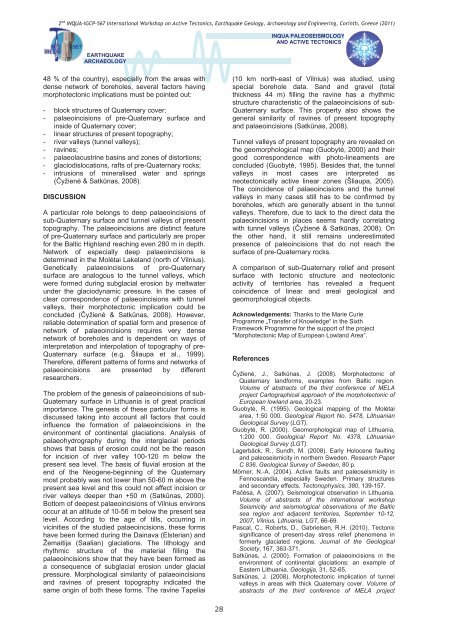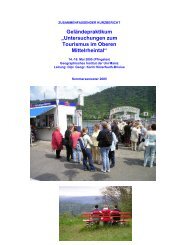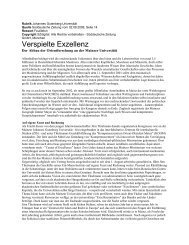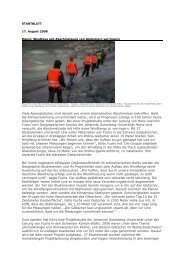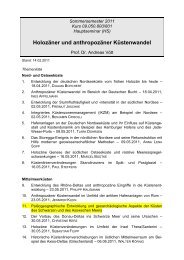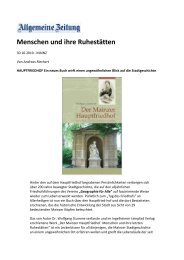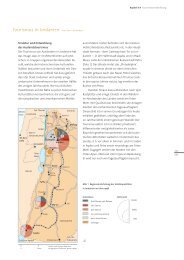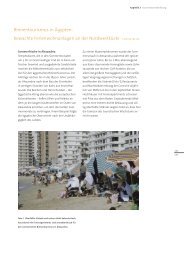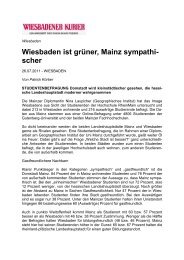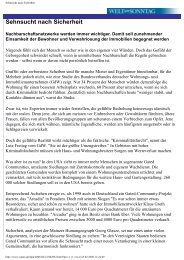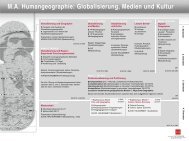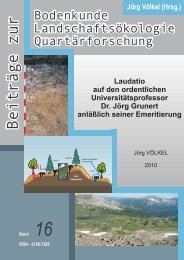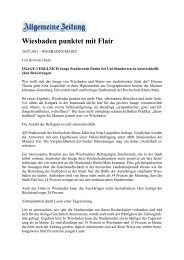Proceedings - Johannes Gutenberg-Universität Mainz
Proceedings - Johannes Gutenberg-Universität Mainz
Proceedings - Johannes Gutenberg-Universität Mainz
Create successful ePaper yourself
Turn your PDF publications into a flip-book with our unique Google optimized e-Paper software.
2 nd INQUA-IGCP-567 International Workshop on Active Tectonics, Earthquake Geology, Archaeology and Engineering, Corinth, Greece (2011)<br />
EARTHQUAKE<br />
ARCHAEOLOGY<br />
INQUA PALEOSEISMOLOGY<br />
AND ACTIVE TECTONICS<br />
48 % of the country), especially from the areas with<br />
dense network of boreholes, several factors having<br />
morphotectonic implications must be pointed out:<br />
- block structures of Quaternary cover;<br />
- palaeoincisions of pre-Quaternary surface and<br />
inside of Quaternary cover;<br />
- linear structures of present topography;<br />
- river valleys (tunnel valleys);<br />
- ravines;<br />
- palaeolacustrine basins and zones of distortions;<br />
- glaciodislocations, rafts of pre-Quaternary rocks;<br />
- intrusions of mineralised water and springs<br />
(yžien & Satknas, 2008).<br />
DISCUSSION<br />
A particular role belongs to deep palaeoincisions of<br />
sub-Quaternary surface and tunnel valleys of present<br />
topography. The palaeoincisions are distinct feature<br />
of pre-Quaternary surface and particularly are proper<br />
for the Baltic Highland reaching even 280 m in depth.<br />
Network of especially deep palaeoincisions is<br />
determined in the Moltai Lakeland (north of Vilnius).<br />
Genetically palaeoincisions of pre-Quaternary<br />
surface are analogous to the tunnel valleys, which<br />
were formed during subglacial erosion by meltwater<br />
under the glaciodynamic pressure. In the cases of<br />
clear correspondence of palaeoincisions with tunnel<br />
valleys, their morphotectonic implication could be<br />
concluded (yžien & Satknas, 2008). However,<br />
reliable determination of spatial form and presence of<br />
network of palaeoincisions requires very dense<br />
network of boreholes and is dependent on ways of<br />
interpretation and interpolation of topography of pre-<br />
Quaternary surface (e.g. Šliaupa et al., 1999).<br />
Therefore, different patterns of forms and networks of<br />
palaeoincisions are presented by different<br />
researchers.<br />
The problem of the genesis of palaeoincisions of sub-<br />
Quaternary surface in Lithuania is of great practical<br />
importance. The genesis of these particular forms is<br />
discussed taking into account all factors that could<br />
influence the formation of palaeoincisions in the<br />
environment of continental glaciations. Analysis of<br />
palaeohydrography during the interglacial periods<br />
shows that basis of erosion could not be the reason<br />
for incision of river valley 100-120 m below the<br />
present sea level. The basis of fluvial erosion at the<br />
end of the Neogene-beginning of the Quaternary<br />
most probably was not lower than 50-60 m above the<br />
present sea level and this could not affect incision or<br />
river valleys deeper than +50 m (Satknas, 2000).<br />
Bottom of deepest palaeoincisions of Vilnius environs<br />
occur at an altitude of 10-56 m below the present sea<br />
level. According to the age of tills, occurring in<br />
vicinities of the studied palaeoincisions, these forms<br />
have been formed during the Dainava (Elsterian) and<br />
Žemaitija (Saalian) glaciations. The lithology and<br />
rhythmic structure of the material filling the<br />
palaeoincisions show that they have been formed as<br />
a consequence of subglacial erosion under glacial<br />
pressure. Morphological similarity of palaeoincisions<br />
and ravines of present topography indicated the<br />
same origin of both these forms. The ravine Tapeliai<br />
(10 km north-east of Vilnius) was studied, using<br />
special borehole data. Sand and gravel (total<br />
thickness 44 m) filling the ravine has a rhythmic<br />
structure characteristic of the palaeoincisions of sub-<br />
Quaternary surface. This property also shows the<br />
general similarity of ravines of present topography<br />
and palaeoincisions (Satknas, 2008).<br />
Tunnel valleys of present topography are revealed on<br />
the geomorphological map (Guobyt, 2000) and their<br />
good correspondence with photo-lineaments are<br />
concluded (Guobyt, 1995). Besides that, the tunnel<br />
valleys in most cases are interpreted as<br />
neotectonically active linear zones (Šliaupa, 2005).<br />
The coincidence of palaeoincisions and the tunnel<br />
valleys in many cases still has to be confirmed by<br />
boreholes, which are generally absent in the tunnel<br />
valleys. Therefore, due to lack to the direct data the<br />
palaeoincisions in places seems hardly correlating<br />
with tunnel valleys (yžien & Satknas, 2008). On<br />
the other hand, it still remains underestimated<br />
presence of paleoincisions that do not reach the<br />
surface of pre-Quaternary rocks.<br />
A comparison of sub-Quaternary relief and present<br />
surface with tectonic structure and neotectonic<br />
activity of territories has revealed a frequent<br />
coincidence of linear and areal geological and<br />
geomorphological objects.<br />
Acknowledgements: Thanks to the Marie Curie<br />
Programme „Transfer of Knowledge“ in the Sixth<br />
Framework Programme for the support of the project<br />
"Morphotectonic Map of European Lowland Area”.<br />
References<br />
yžien, J., Satknas, J. (2008). Morphotectonic of<br />
Quaternary landforms, examples from Baltic region.<br />
Volume of abstracts of the third conference of MELA<br />
project Cartographical approach of the morphotectonic of<br />
European lowland area, 20-23.<br />
Guobyt, R. (1995). Geological mapping of the Moltai<br />
area, 1:50 000. Geological Report No. 5478, Lithuanian<br />
Geological Survey (LGT).<br />
Guobyt, R. (2000). Geomorphological map of Lithuania,<br />
1:200 000. Geological Report No. 4378, Lithuanian<br />
Geological Survey (LGT).<br />
Lagerbäck, R., Sundh, M. (2008). Early Holocene faulting<br />
and paleoseismicity in northern Sweden. Research Paper<br />
C 836, Geological Survey of Sweden, 80 p.<br />
Mörner, N.-A. (2004). Active faults and paleoseismicity in<br />
Fennoscandia, especially Sweden. Primary structures<br />
and secondary effects. Tectonophysics, 380, 139-157.<br />
Pasa, A. (2007). Seismological observation in Lithuania.<br />
Volume of abstracts of the international workshop<br />
Seismicity and seismological observations of the Baltic<br />
sea region and adjacent territories, September 10-12,<br />
2007, Vilnius, Lithuania, LGT, 66-69.<br />
Pascal, C., Roberts, D., Gabrielsen, R.H. (2010). Tectonic<br />
significance of present-day stress relief phenomena in<br />
formerly glaciated regions. Journal of the Geological<br />
Society, 167, 363-371.<br />
Satknas, J. (2000). Formation of palaeoincisions in the<br />
environment of continental glaciations: an example of<br />
Eastern Lithuania. Geologija, 31, 52-65.<br />
Satknas, J. (2008). Morphotectonic implication of tunnel<br />
valleys in areas with thick Quaternary cover. Volume of<br />
abstracts of the third conference of MELA project<br />
28


